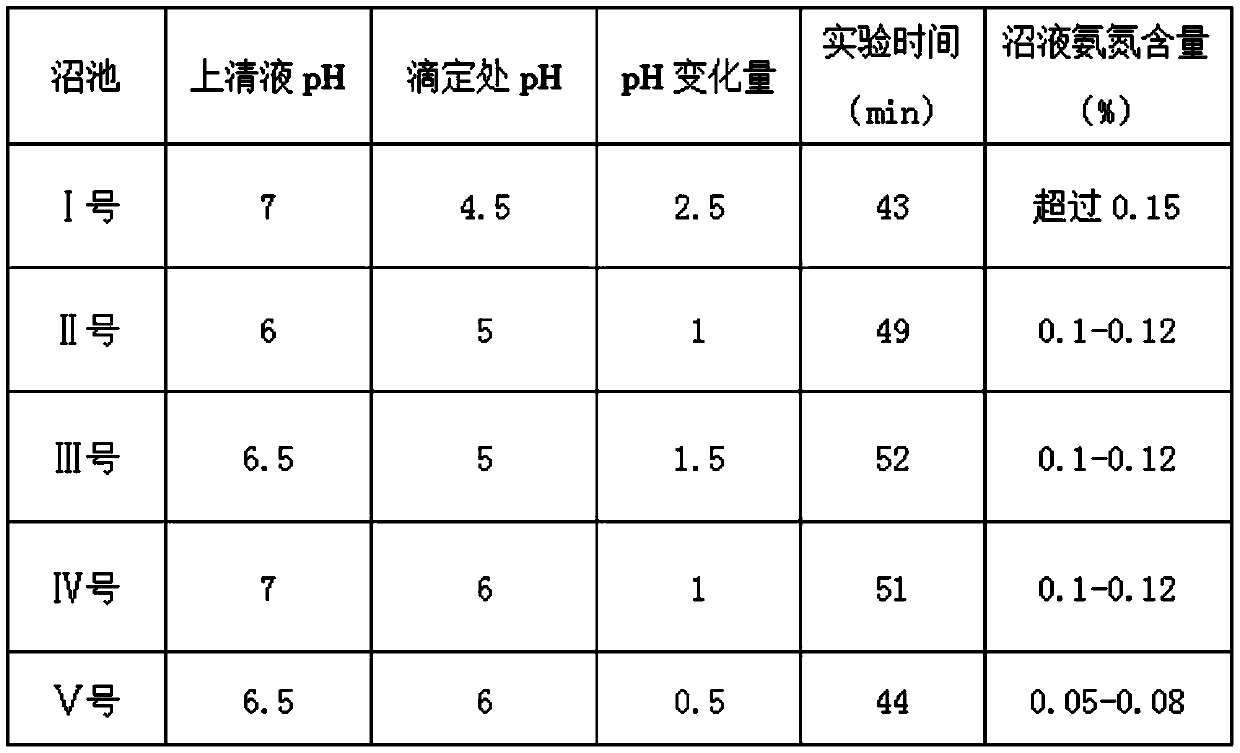A method for rapid determination of ammonia nitrogen content in biogas slurry
A technology for rapid determination of ammonia nitrogen content, which can be used in the preparation of test samples, material analysis by observing the impact on chemical indicators, and analysis by making materials undergo chemical reactions. It can solve inaccurate test results and dilution errors. , Distillation failure and other problems, to achieve the effect of simple experimental principle, no interference factors, and short reaction time
- Summary
- Abstract
- Description
- Claims
- Application Information
AI Technical Summary
Problems solved by technology
Method used
Image
Examples
Embodiment 2
[0030] [Example 2] Sampling points were set and sampled in the upper, middle and lower layers of No. Ⅱ biogas pond respectively. There were 3 sampling points in each layer, and the volume of biogas slurry sampled at each sampling point was 200ml. All the obtained samples were mixed and filtered with a 150-mesh filter, and diluted 40 times to obtain 72L of the test solution. Heat the solution to be tested to 60 degrees Celsius, add 720mg of PAC, and gradually add 267mg of CTS under stirring. After three minutes, large flocs and clear supernatant appear in the solution. The pH of the supernatant is 6 when measured with pH test paper. Get the supernatant and drop it on the ammonia nitrogen detection test paper with a formaldehyde concentration of 71%, and obtain a pH of 5 after the reaction at the titration point.
Embodiment 3
[0031] [Example 3] Divide No. Ⅲ biogas pond into five height layers on average in the vertical direction, set two sampling points in each layer, and the volume of biogas slurry sampled at each sampling point is 200ml. All the obtained samples were mixed and filtered with a 200-mesh filter, and diluted 50 times to obtain 100L of the test solution. Heat the solution to be tested to 65 degrees Celsius, add 1.5g of PAC, and gradually add 0.5g of CTS under stirring. After a little more than one minute, large flocs and clear supernatant appear in the solution. Use pH test paper to measure the concentration of the supernatant. The pH is 6.5. Get the supernatant and drop it on the ammonia nitrogen detection test paper with a formaldehyde concentration of 78%, and obtain a pH of 5 after the reaction at the titration point.
Embodiment 4
[0032] [Example 4] Sampling points were set and sampled in the upper, middle and lower layers of No. IV marsh pond respectively. There were 3 sampling points in each layer, and the volume of biogas slurry sampled at each sampling point was 200ml. All the obtained samples were mixed and filtered with a 150-mesh filter, and diluted 40 times to obtain 72L of the test solution. Heat the solution to be tested to 60 degrees Celsius, add 720mg of PAC, and gradually add 267mg of CTS under stirring. After three minutes, large flocs and clear supernatant appear in the solution. The pH of the supernatant is 7 when measured with pH test paper. Get the supernatant and drop it on the ammonia nitrogen detection test paper with a formaldehyde concentration of 71%, and obtain a pH of 6 after the reaction at the titration point.
PUM
| Property | Measurement | Unit |
|---|---|---|
| degree of polymerization | aaaaa | aaaaa |
Abstract
Description
Claims
Application Information
 Login to View More
Login to View More - R&D
- Intellectual Property
- Life Sciences
- Materials
- Tech Scout
- Unparalleled Data Quality
- Higher Quality Content
- 60% Fewer Hallucinations
Browse by: Latest US Patents, China's latest patents, Technical Efficacy Thesaurus, Application Domain, Technology Topic, Popular Technical Reports.
© 2025 PatSnap. All rights reserved.Legal|Privacy policy|Modern Slavery Act Transparency Statement|Sitemap|About US| Contact US: help@patsnap.com

